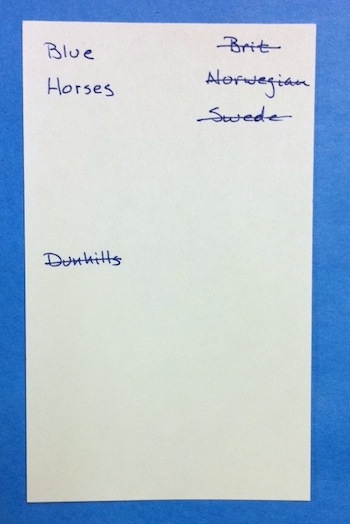Brainteaser
December 5, 2010 at 8:48 AM by Dr. Drang
Last weekend, I forced my older son to take a break from Minecraft and Black Ops and work with me on this brainteaser from Coudal Partners:1
There are five houses in a row in different colors. In each house lives a person with a different nationality. The five owners drink a different drink, smoke a different brand of cigar and keep a different pet, one of which is a Walleye Pike.
The question is—who owns the fish?
Hints:
1. The Brit lives in the red house.
2. The Swede keeps dogs as pets.
3. The Dane drinks tea.
4. The green house is on the left of the white house.
5. The green house owner drinks coffee.
6. The person who smokes Pall Malls keeps birds.
7. The owner of the yellow house smokes Dunhills.
8. The man living in the house right in the center drinks milk.
9. The man who smokes Blends lives next to the one who keeps cats.
10. The Norwegian lives in the first house.
11. The man who keeps horses lives next to the one who smokes Dunhills.
12. The owner who smokes Bluemasters drinks beer.
13. The German smokes Princes.
14. The Norwegian lives next to the blue house.
15. The man who smokes Blends has a neighbor who drinks water.There are no tricks, pure logic will get you the correct answer. And yes, there is enough information to arrive at the one and only correct answer.
I suggested we use index cards to record what we knew; one card for each house. We moved the cards around on the table to keep track of their positions on the street. Here’s an example of one partway through the solution:

The items with the lines through them are eliminated possibilities. For example, since the Brit lives in a red house (Clue 1) and this is a blue house, we know the Brit doesn’t live here. Similarly, Clue 14 tells us the Norwegian doesn’t live here, and so on.
That’s my writing on the card. Initially, I had my son write down the clues, but that was a disaster. He put information about different categories next to each other and information about the same category on different parts of the card. It was impossible to know what we knew. I’m sure it will be shocking—shocking, I tell you!—to parents of teenagers to hear that a fourteen-year-old boy was not particularly well organized.
But while the fourteen-year-old brain may not be good at organization, it sure is supple. Often I would stop to ask questions like “Wait, how do we know the Swede doesn’t live here?” and he would immediately answer “Because the Swede keeps dogs, and we know this guy keeps horses because he’s the only possible neighbor of the yellow house.” Oh, right.
I’m convinced we develop organizational skills as adults because that’s when we need them.
If you decide to try the puzzle, here’s a hint on strategy. Deduction alone won’t get you to the solution. Eventually, you’ll get to a point where you’ve eliminated most of the possibilities, but not enough to know a category for sure. At that point, you’ll have to make a guess and follow out the consequences of the guess, looking for a contradiction. If you find one, you’ll know the guess was wrong; start that chain of reasoning again with a different guess.
The Coudal page has links to the solution, but you probably won’t need them. When you’ve got the right answer you’ll know it because it fits all the clues.
-
For the record, I don’t believe the purported Einstein connection—that’s almost certainly a fillip intended to give the puzzle additional appeal. There are hundreds, if not thousands, of logic puzzles with this same form, and I don’t see where this one is special. ↩
